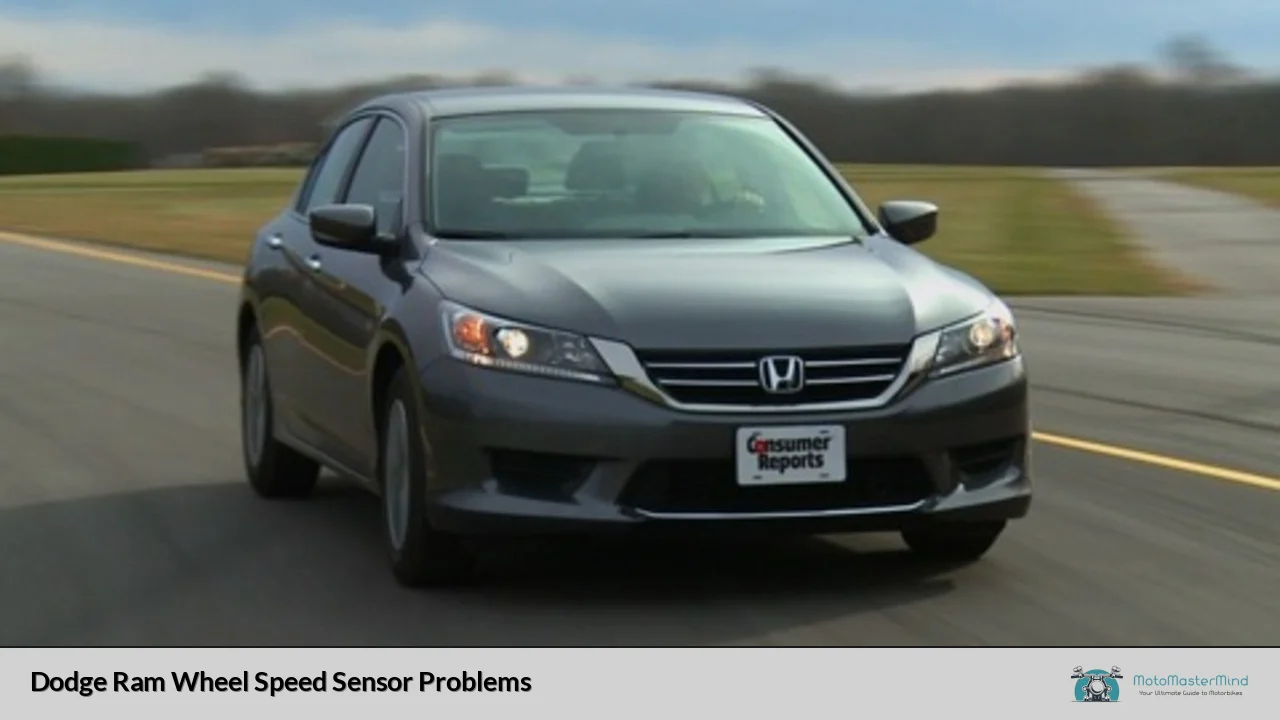Are you tired of dealing with Dodge Ram wheel speed sensor problems? Well, you’re not alone. Many Dodge Ram owners have experienced frustrating issues with their wheel speed sensors, causing headaches and potentially compromising safety. In this article, we’ll dive into the details of these problems and explore possible solutions.
Firstly, let’s understand what a wheel speed sensor does. Essentially, it monitors the rotational speed of each wheel and sends that information to the vehicle’s anti-lock braking system (ABS) and traction control system (TCS). This allows the ABS and TCS to apply the brakes or modulate power to individual wheels when necessary, improving overall stability and control.
Now, onto the problems. One common issue is a faulty wheel speed sensor, which can result in erratic readings or complete failure. This malfunction can trigger warning lights on your dashboard, such as the ABS or TCS light. Additionally, you may experience ABS or TCS system activation during normal driving conditions or even brake pedal pulsations.
Another problem arises from sensor contamination. The wheel speed sensors are exposed to various elements, including dirt, debris, and moisture. Over time, this can cause build-up or corrosion on the sensors, leading to inaccurate readings or sensor failure. It’s essential to keep the sensors clean and inspect them regularly.
Furthermore, wiring and connection problems can occur. The wheel speed sensors are connected to the vehicle’s electrical system, and any loose or damaged wiring can disrupt the signals between the sensors and the ABS/TCS modules. This can result in intermittent or permanent loss of sensor data.

So, how can you address these issues? If you suspect a faulty wheel speed sensor, it’s advisable to have it diagnosed by a qualified mechanic. They can use specialized diagnostic tools to pinpoint the exact problem and determine whether a sensor replacement is necessary.
Regular maintenance is crucial in preventing sensor contamination. Make sure to clean the sensors during routine brake inspections and remove any debris or buildup. Additionally, check the wiring connections for any signs of damage and have them repaired if needed.
Dodge Ram wheel speed sensor problems can be a frustrating ordeal. Whether it’s a faulty sensor, contamination, or wiring issues, addressing these problems promptly is essential for your safety on the road. By staying vigilant and performing regular maintenance, you can minimize the chances of encountering these troublesome issues and enjoy a smoother driving experience.
Unveiling the Achilles’ Heel: The Hidden Challenges Behind Dodge Ram Wheel Speed Sensors
Have you ever wondered what keeps your Dodge Ram truck running smoothly on the road? It’s the intricate network of components working together, and one crucial element that often goes unnoticed is the wheel speed sensors. These little devices play a significant role in ensuring your vehicle maintains optimal performance and safety, but they also come with their fair share of challenges.
When it comes to Dodge Ram wheel speed sensors, reliability is key. These sensors provide vital information to the truck’s onboard computer system about the rotational speed of each wheel. This data is essential for various systems, including anti-lock brakes (ABS), traction control, and stability control. Without accurate input from the wheel speed sensors, these safety features can become compromised, putting you and your passengers at risk.
However, despite their importance, wheel speed sensors are not immune to problems. One common issue is sensor malfunction caused by dirt, debris, or moisture intrusion. As the sensors are located near the wheels, they are exposed to harsh conditions, including road salt, mud, and water. Over time, these contaminants can hinder the sensors’ performance, leading to inaccurate readings or complete failure.
Another challenge lies in the wiring harness connected to the wheel speed sensors. The constant vibration and movement of the wheels can cause wear and tear on the wires, resulting in intermittent connectivity or broken connections. A faulty wiring harness can disrupt the flow of information from the sensors to the computer system, potentially triggering warning lights on the dashboard or causing the safety systems to engage unexpectedly.
Dealing with these hidden challenges requires a proactive approach. Regular maintenance and inspection of the wheel speed sensors and their surrounding components can help identify potential issues early on. Cleaning the sensors and protecting them from excessive exposure to dirt and moisture can contribute to their longevity. Additionally, ensuring the integrity of the wiring harness and addressing any signs of wear or damage promptly can prevent unexpected sensor failures.
While the Dodge Ram wheel speed sensors may seem like small and insignificant components, they play a crucial role in maintaining your truck’s performance and safety. Understanding the hidden challenges they face, such as dirt intrusion and wiring issues, empowers you to take proactive measures to keep them functioning optimally. So, the next time you hit the road, remember the Achilles’ heel of your Dodge Ram lies in those tiny yet mighty wheel speed sensors.
Road Warriors Beware: Dodge Ram Owners Grapple with Troublesome Wheel Speed Sensor Glitches
Road trips can be an exhilarating adventure, but for Dodge Ram owners, there’s a troublesome glitch that can put a damper on their journey: wheel speed sensor issues. These glitches have become a thorn in the side of many road warriors, causing frustration and potential safety concerns.
So, what exactly is a wheel speed sensor? In simple terms, it’s a small device located near each wheel that monitors the rotational speed of the wheels. This information is crucial for various systems in the vehicle, including the anti-lock braking system (ABS) and traction control. It helps ensure that your Dodge Ram maintains optimal performance and stability on the road.

Unfortunately, some Dodge Ram owners have experienced glitches with their wheel speed sensors. These glitches can manifest in different ways, such as ABS or traction control warning lights illuminating on the dashboard, erratic braking behavior, or even complete failure of these safety systems. Imagine cruising down the highway, only to suddenly lose control due to a malfunctioning wheel speed sensor – it’s a situation no driver wants to face!
The causes of these glitches can vary. Sometimes, it’s simply a matter of wear and tear over time, as the sensors are exposed to harsh road conditions. Other times, it could be due to faulty wiring or electrical connections. Regardless of the cause, the result is the same: a frustrating and potentially dangerous situation for Dodge Ram owners.
If you find yourself grappling with a troublesome wheel speed sensor glitch, it’s important to address the issue promptly. Ignoring the problem can compromise your safety and lead to more expensive repairs down the road. The best course of action is to take your Dodge Ram to a qualified mechanic who can diagnose and fix the problem. They will have the expertise and specialized tools to identify the root cause of the glitch and provide an effective solution.
Revving into Turbulence: How Dodge Ram Wheel Speed Sensor Issues Are Causing Concerns for Drivers
Are you a proud owner of a Dodge Ram? Well, buckle up because we’re about to dive into a topic that has been revving up some serious concerns among Dodge Ram drivers. Yes, you guessed it right! We’re talking about the notorious Dodge Ram wheel speed sensor issues that have been causing turbulence on the roads.
Picture this: you’re cruising down the highway, enjoying the power and ruggedness of your beloved Ram when suddenly, the dreaded ABS warning light illuminates on your dashboard. Panic sets in as you realize something is not right with your wheels. Welcome to the world of Dodge Ram wheel speed sensor problems!
But what exactly is a wheel speed sensor, you ask? Put simply, it’s a small but mighty component responsible for measuring the rotational speed of each wheel. This information is crucial for various safety systems, such as the anti-lock braking system (ABS) and traction control. When the wheel speed sensor malfunctions, it can wreak havoc on these systems, compromising your safety and driving experience.
Now, let’s dig deeper into the specific issues faced by Dodge Ram owners. One common problem is sensor failure due to corrosion or damage caused by road debris. Water, salt, and dirt can take their toll on these sensors, leading to inaccurate readings or complete failure. This can result in unexpected ABS activation, brake pulsation, or even loss of traction control, making driving a nerve-wracking experience.
Furthermore, faulty wheel speed sensors can also trigger the infamous “Dodge death wobble.” Imagine feeling a violent shaking in the steering wheel at high speeds—definitely not the adrenaline rush you were seeking! This phenomenon occurs when the sensors fail to accurately detect wheel speed, causing an imbalance in the suspension system.
To make matters worse, replacing a Dodge Ram wheel speed sensor can be a costly affair. Not only do you have to bear the expense of the sensor itself, but also the labor costs involved in its installation. This predicament has left many Dodge Ram owners frustrated and concerned about the reliability and longevity of their vehicles.
Navigating a Bumpy Ride: The Perplexing World of Dodge Ram Wheel Speed Sensor Failures
Are you tired of dealing with unexpected issues in your Dodge Ram? One particularly perplexing problem that many owners face is wheel speed sensor failures. These sensors play a crucial role in ensuring the smooth operation of your vehicle’s anti-lock braking system (ABS) and traction control system (TCS). In this article, we will delve into the intricate details of Dodge Ram wheel speed sensor failures and provide you with some insights on how to navigate this bumpy ride.
So, what exactly is a wheel speed sensor? Well, think of it as the eyes of your vehicle. It constantly monitors the rotational speed of each wheel and relays this information to the ABS and TCS systems. This allows these systems to make quick adjustments and prevent wheel lock-up during braking or loss of traction on slippery surfaces. However, when a wheel speed sensor fails, it can cause some serious headaches.
One common symptom of a failing wheel speed sensor is an illuminated ABS or TCS warning light on your dashboard. You may also experience erratic braking behavior, such as the ABS kicking in unnecessarily or the brakes pulsating when you come to a stop. Additionally, your TCS may engage even on dry pavement, reducing engine power and affecting your vehicle’s performance.
Now, let’s talk about the potential causes of these failures. One major culprit is dirt and debris accumulation around the sensors. Over time, this buildup can interfere with the sensor’s ability to accurately detect wheel speed. Another factor is corrosion. Moisture and road salt can cause the sensor connectors and wiring to corrode, resulting in faulty readings.
To navigate this perplexing world of Dodge Ram wheel speed sensor failures, there are a few steps you can take. Regularly inspect and clean the sensors to remove any dirt or debris. Be cautious when driving through muddy or off-road terrain to minimize the risk of sensor damage. Additionally, consider applying dielectric grease to the connectors to protect against corrosion.

Dealing with Dodge Ram wheel speed sensor failures can be a challenging and perplexing task. By understanding the importance of these sensors and taking preventive measures, you can minimize the likelihood of encountering such issues. Remember to stay vigilant, keep your sensors clean, and protect them from corrosion. Happy and safe driving!

